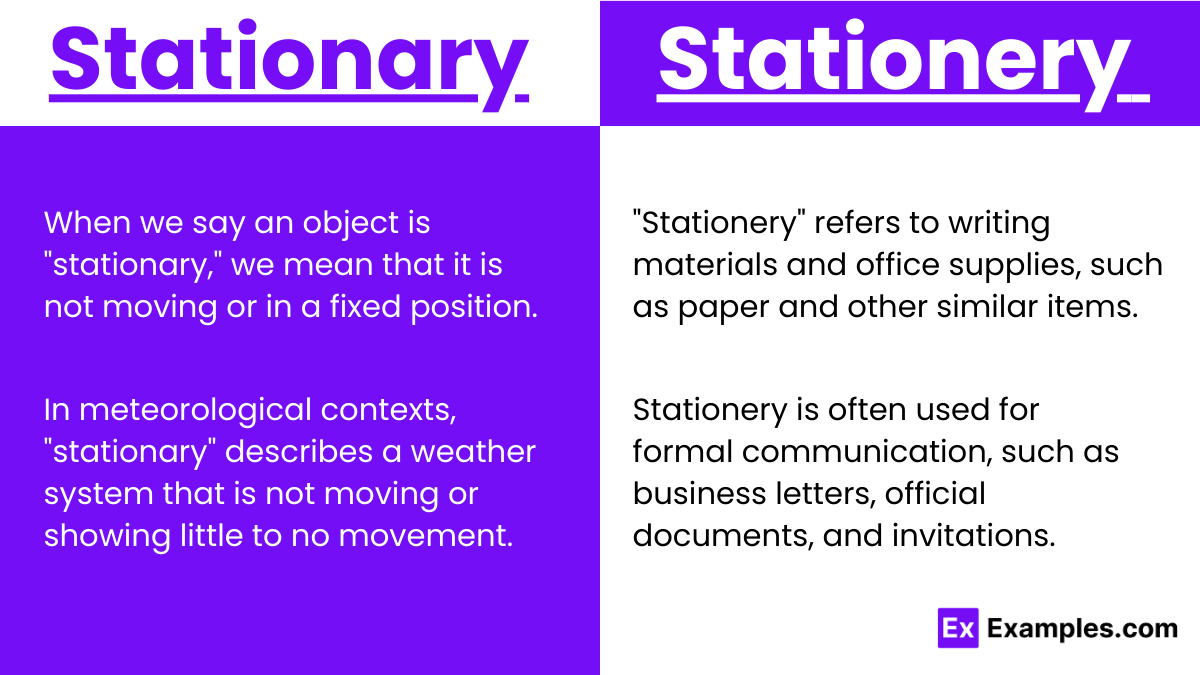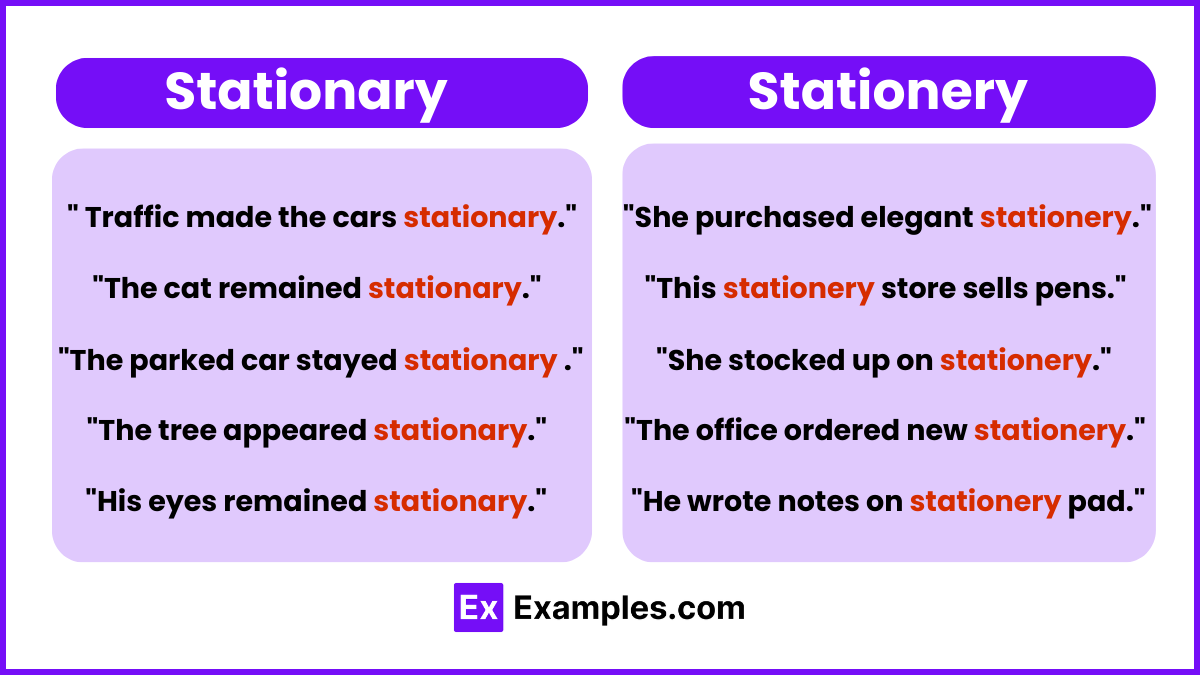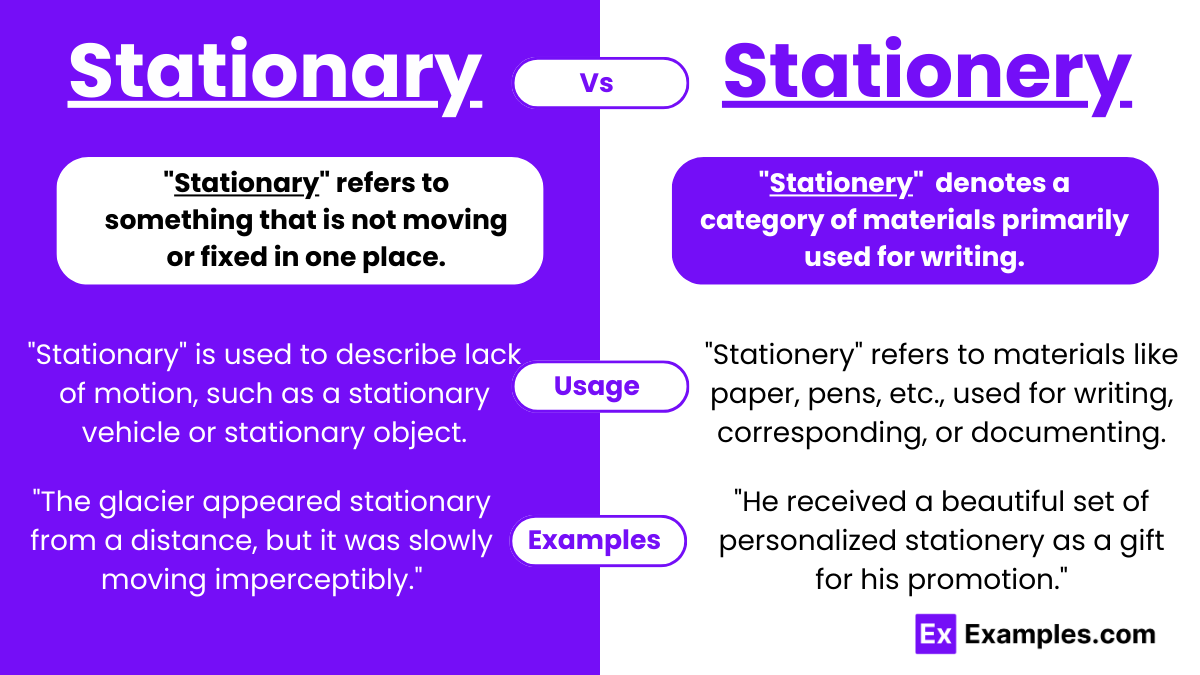Stationary vs Stationery – Meanings, Difference, Usage, Examples
Have you ever found yourself puzzled by the similar-looking words “stationary” and “stationery“? Despite their nearly identical appearance, they couldn’t be more different in meanings. “Stationary” refers to something that is not moving or fixed in one place, while “stationery” pertains to materials used for writing, such as paper, pens, and envelopes. In this guide, we’ll unravel the confusion surrounding these two words and provide easy tricks to remember which is which.
Stationary and Stationery – Meanings
- The term “stationary” functions as an adjective, refers to something that is not in motion, fixed in place, or unchanging. It typically describes objects, people, or situations that remain still or stable without movement.
- “Stationery” operates as a noun, denotes a category of materials primarily used for writing, such as paper, envelopes, pens, pencils, and other office supplies. It encompasses items essential for correspondence, note-taking, or formal communication.
Summary
“Stationary” refers to something that is not moving or changing position, such as a stationary object or a stationary bike. “Stationery” refers to materials used for writing, such as paper, pens, pencils, and envelopes. Though they look alike, they mean different things, so it’s important to use them correctly.
How to Pronounce Stationary and Stationery
- Stationary: Pronounced as /ˈsteɪʃəˌnɛri/ (rhymes with “stationery”)
- Stationery: Pronounced as /ˈsteɪʃəˌnəri/ (rhymes with “cannery”)
Differences between Stationary and Stationery
| Aspect | Stationary | Stationery |
|---|---|---|
| Definition | Describes something not moving or fixed in one place | Refers to writing materials used for correspondence |
| Nature | Implies immobility or lack of movement | Pertains to writing instruments and related items |
| Usage | Typically used to describe a lack of motion | Used when referring to writing supplies and materials |
| Application | Describes objects, people, or situations that are still or fixed | Refers to materials used for writing purposes |
| Physical Action | Suggests lack of movement or motion | Associated with writing, corresponding, or documenting |
| Noun/Adjective | Primarily used as an adjective | Primarily used as a noun |
| Common Contexts | Found in discussions related to lack of movement or stability | Often used in contexts of writing, correspondence, or office supplies |
How to Remember the Difference between Stationary and Stationery
- Stationary: Think of the “a” in “stationary” as standing for “not moving,” similar to “staying” in one place.
- Stationery: Remember the “e” in “stationery” as representing “envelopes” or “writing equipment.”
How to use Stationary and Stationery

- To use “stationary” correctly: Identify situations where something is not moving or fixed in one place. “Stationary” is used to describe immobility or lack of motion, such as a stationary vehicle or stationary object.
- To use “stationery” appropriately: Consider contexts where writing materials are involved. “Stationery” refers to materials like paper, pens, envelopes, etc., used for writing, corresponding, or documenting.
When to Use Stationary and Stationery
Stationary:
- A parked car on the side of the road: This signifies a car that has come to a stop and remains stationary until the driver decides to resume movement.
- A traffic light when it’s red: This indicates a phase where vehicles must halt, and the traffic light itself remains stationary, fixed in its position until it changes to green.
- A statue in a park: Statues are immobile sculptures often erected for artistic or commemorative purposes, serving as permanent fixtures within a landscape.
- A bookshelf filled with books: Books placed on a bookshelf remain stationary unless someone physically removes or rearranges them, maintaining their position until acted upon.
- A tree in a backyard: Trees, being rooted in the ground, are inherently stationary structures, providing stability and visual aesthetics to outdoor spaces.
Stationery:
- Writing a letter to a friend: This involves utilizing stationery like paper and a pen, enabling the expression of thoughts and emotions through written communication.
- Purchasing envelopes and stamps: These are essential stationery items for sending mail, providing packaging and postage necessary for correspondence.
- Taking notes during a lecture: Using stationery such as a notebook and pencil facilitates the organization and retention of information conveyed during educational sessions.
- Making a shopping list: Stationery like a notepad serves as a practical tool for listing items needed for shopping, aiding in planning and organization.
- Drawing a picture: Artists use stationery supplies like drawing paper and colored pencils to create visual art, allowing for expression and creativity in various forms.
Examples – Stationary and Stationery

Stationary Examples
- The car remained stationary at the red light.
- The ship was stationary in the harbor.
- The statue stood stationary in the park.
- The old clock on the mantelpiece remained stationary, its hands frozen in time.
- The glacier appeared stationary from a distance, but it was slowly moving imperceptibly.
Stationery Examples
- She bought a set of personalized stationery for her business.
- The office supply store sells various types of stationery.
- He wrote a letter using elegant stationery.
- The students decorated their classroom with handmade stationery for the bulletin board.
- He received a beautiful set of personalized stationery as a gift for his promotion.
Synonyms
| Stationary (not moving) | Stationery (writing materials) |
|---|---|
| Still | Writing supplies |
| Motionless | Office supplies |
| Unmoving | Paper goods |
| Fixed | Writing implements |
| Immobile | Letterhead |
| Static | Desk accessories |
Exercise
- She noticed the cat sitting ___ by the window.
- He purchased new ___ for his office, including pens, paper, and envelopes.
- The traffic lights turned red, and the cars came to a ___.
- They wrote their thank-you notes on personalized ___.
Answers
- Stationary
- Stationery
- Stationary
- Stationery
FAQ’S
What is the difference between stationary and stationery?
Stationary refers to something not moving, while stationery refers to writing materials like paper and pens.
Is school stationary or stationery?
School supplies like notebooks and pencils are considered stationery, not stationary.
Why is it called stationary?
“Stationary” comes from the Latin word “stationarius,” meaning “belonging to a station or post,” reflecting its meaning of not moving.
How do you spell stationary as in pens and paper?
The correct spelling for pens and paper is “stationery.”
How do Americans spell stationary?
Americans spell stationary the same way as in British English, as “stationery.”
How do Americans spell stationery?
Americans spell stationery the same way as in British English, as “stationery.”


